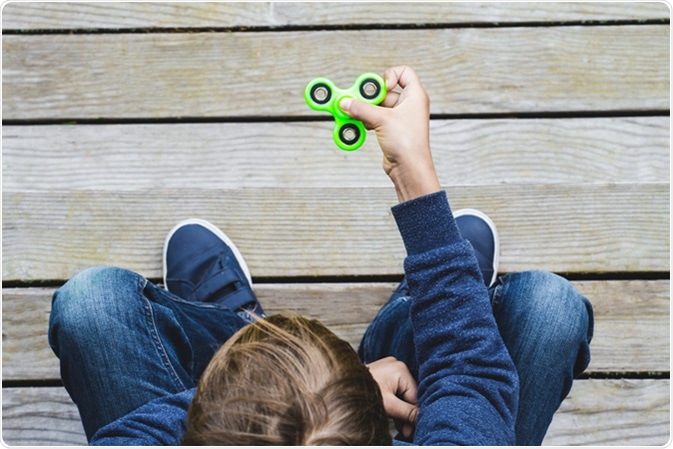
Anxiety Disorders in Children
Anxiety is a common reaction to stress or anticipated danger. It helps individuals to prepare for and take action to avoid the source of threat or handle the situation that is likely to arise. However, in some people, anxiety becomes intense and acute, or lasts well beyond the time when it is useful.
This can actually negatively affect the individual’s daily life and reactions at which point it becomes anxiety disorder. Such conditions include separation anxiety, social anxiety, obsessive-compulsive disorder and various phobias. Anxiety disorders are among the most common of pediatric mental health conditions in the US.

Image Credit: Veja / Shutterstock
Causes of Anxiety in Children
Among other reasons, children may develop anxiety for any of the following:
- Trouble within the domestic environment
- Traumatic life events
- Loss of loved family members or friends
- School-related anxiety, including academic worries or bullying
Signs of Anxiety Disorder
Children may show signs of anxiety disorder such as:
- Difficulty in concentration
- Sleep problems, including waking with nightmares
- Loss of appetite or changes in food habits
- Frequent complaints of illness
- Mood changes, including tearfulness or irritability for no apparent reason
- Feelings of fear or panic
Common Types of Anxiety Disorder in Childhood
Children and adolescents may experience any of the following types of anxiety disorder:
- Fears or phobias
- Separation anxiety
- Generalized anxiety disorder
- Social anxiety
Fears or phobias of particular situations may develop due to entities, such as monsters, bogeys, water and strange animals. The difference between fear of unknown or known negatively-experienced events or objects, and a phobia, is that a normal fear can be overcome and does not overwhelm the rest of one’s life. In contrast, a phobia is consuming and may eventually occupy the whole of one’s thoughts and determine the reactions.
Separation anxiety refers to the fear that some children display when they are separated from their parents or regular care-givers, usually around 6 months of age. If it persists and intensifies, children are likely to find their first preschools or daycare facilities a source of great anxiety. At times, separation anxiety may indicate the presence of family difficulties or changes.
Generalized anxiety disorder refers to a pervasive and unreasonable sense of anxiety, which is distinguished from fear or worry by the absence of any clear cause or time period. It is a rather long-term condition and affects one’s thinking about a wide array of life situations and problems rather than any specific situation, which one is actually going through or is likely to face soon. If a child with this condition is counseled about one issue, worry about another situation will manifest at once, and so the anxiety is not allayed.
A child may be shy, but may still look forward to spending time with friends or in a social setting where the activity is likely to be enjoyable. However, children with social anxiety will always hesitate to go out of their comfort zones, whether in their homes or just their rooms. Shopping, answering the phone, going to school, traveling by public transport, or meeting friends is always anxiety-arousing irrespective of the others involved in the activity. This anxiety is real, gut-wrenching fear rather than a mild apprehension, and restrains the child from any public interaction whatsoever.
Post-traumatic stress disorder and obsessive compulsive disorder are other rarer forms of anxiety disorder in children.
Consequences
The presence of long-term anxiety in childhood is a trying and consuming process, which can cause extreme stunting of the person’s emotional growth, social development, academic fulfilment, family life and overall development. These disorders are likely to persist into later life and plague the child throughout adult life. They may induce full-fledged mental disorders in adolescence or early adulthood, such as depression, alcohol abuse, drug addiction and suicidal tendencies.
Treatment
Anxiety disorders are varied and therefore a wide range of options is offered to children in order to treat them. These include modalities, such as medication, counseling and cognitive-behavioral therapy, depending on the type of disorder.
Medication
Medications are used only in cases of severe anxiety disorder not treatable by counseling or other interventions. They may take up to 4 weeks to produce a clinical effect and therefore this period of time should be allowed to pass before asking for a change in the type or dosage of medication.
Counseling
Many children suffering from anxiety disorder may not be able to find a sympathetic hearer or understanding person to confide in or ask advice. For such children a professional counselor can offer help or a neutral place to unload their worries and fears, with the knowledge that their families are not involved in the conversation. They find it easier to talk over some things with another person who is not related to them or part of their day-to-day environment. Professional counselors can help work out ways to cope with the source of the anxiety.
Cognitive Behavioral Therapy
Cognitive behavioral therapy or CBT is also called talk therapy. It is offered by professionals who can help children with anxiety to work through their thoughts and actions. They analyze the behavior of these children to bring about desired and productive changes in them.
References
- http://www.nhs.uk/conditions/anxiety-children/Pages/Introduction.aspx#signs
- https://www.nimh.nih.gov/health/statistics/prevalence/any-anxiety-disorder-among-children.shtml
- https://www.gov.uk/government/uploads/system/uploads/attachment_data/file/508847/Mental_Health_and_Behaviour_-_advice_for_Schools_160316.pdf
- https://www.ncbi.nlm.nih.gov/pmc/articles/PMC1071700/
Further Reading
Last Updated: Feb 26, 2019






















.png)










No hay comentarios:
Publicar un comentario